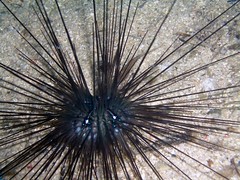There’s a funny animal that lives on the floor of the ocean and likes to eat what most of us would only wipe off the bottom of our shoes. It’s name is the sea cucumber. The sea cucumber is an echinoderm and is closely related to sea stars, sea urchins, and sand dollars.To protect itself the sea cucumber will expel its intestines outside of its body to distract predators. The sea cucumber is a prized Japanese culinary tradition used often in soups and stews. Fisheries along the Atlantic coast have been popping up in the past twenty years to sell sea cucumbers.
Check out this video from National Geographic on how they (literally) fight with guts for glory:
Do you have another great question? Simply email me at info@beachchairscientist.com.

 dollar and a few others that all have these things in common: fivefold
dollar and a few others that all have these things in common: fivefold 








What people are saying …